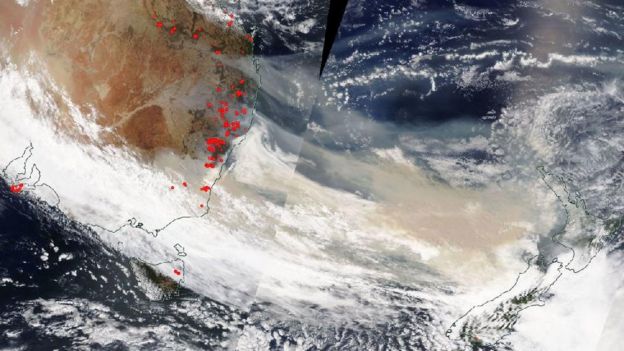Bushfire smoke as seen near the International Space Station The unprecedented scale and intensity of the fires has been exacerbated by climate change, experts say.A fleet of NASA satellites ðŸ›°ï¸ working together has been analyzing the aerosols and smoke from the massive fires burning in Australia.https://t.co/93geNvCBnU pic.twitter.com/ZedZ199lvJ
— NASA Goddard (@NASAGoddard) January 9, 2020
How has the smoke travelled around the world?
Nasa said recent blazes had been so big they had produced an "unusually large" number of pyrocumulonimbus events - or fire-generated thunderstorms. These had sent smoke soaring into the stratosphere, with some recorded as high as 17.7km (11 miles). "Once in the stratosphere, the smoke can travel thousands of miles from its source, affecting atmospheric conditions globally," Nasa said. A satellite image showing smoke travelling towards New Zealand on 5 January
The agency said it was studying the effects of smoke at this altitude and whether it provided "a net atmospheric cooling or warming".
A satellite image showing smoke travelling towards New Zealand on 5 January
The agency said it was studying the effects of smoke at this altitude and whether it provided "a net atmospheric cooling or warming".
What has been the smoke's impact closer to ground?
Nasa noted the smoke had changed the colour of skies in South America, and dramatically affected New Zealand, where it was "causing severe air quality issues" and "visibly darkening mountaintop snow". Large Australian cities including Sydney, Melbourne, Canberra, and Adelaide have also endured dangerous air quality levels due to smoke from nearby bushfires. On Tuesday, Melbourne residents were enduring a second consecutive day of "hazardous" air quality, prompting concerns about public health. More than 100 fires continue to burn in the nation's east, however cooler conditions in recent days and forecast rain have aided firefighting efforts.DISCLAIMER: The Views, Comments, Opinions, Contributions and Statements made by Readers and Contributors on this platform do not necessarily represent the views or policy of Multimedia Group Limited.
Tags:
Latest Stories
-
Burkina Faso army massacred 223 villagers in revenge attack – HRW
2 mins -
Germany detains alleged Nigerian mafia members
6 mins -
Manhyia Palace hosts royals, dignitaries from Ghana and beyond at special Awukudee
13 mins -
Celestine Donkor speaks on report of undergoing weight loss surgery
36 mins -
Bright Simons: The SML defence “falls flat”
43 mins -
We need long term macroeconomic stability to build a strong and vibrant economy – Deloitte Boss
43 mins -
Adomaa Adjeman to make theatre debut as Aku Sika in Prof Martin Owusu’s epic
45 mins -
U.S. government supports Ghanaian partners to protect Intellectual Property
51 mins -
Eric Johnson
57 mins -
Tanzania denies abuse reports as World Bank halts funds
1 hour -
2024 polls: The person I defeated twice can’t succeed me – Akufo-Addo
1 hour -
NBA: Miami Heat beat Boston Celtics to even series
1 hour -
Two sentenced for stealing over 1,000 bags of rice
1 hour -
Zulu monarchy in row over king’s praise singer
1 hour -
Xavi to remain as Barcelona coach until at least June 2025
2 hours

